If you talk about analog Synthesizers, companies like KORG, Dave Smith Instruments or Analogue Solutions come to mind. All these companies have something in common, they have already introduced excellent modern analog Synthesizers in the last years on the market.
At the beginning of the year, however, there was also a company that presented a Synthesizer product for the first time. Pioneer DJ is well-known for high-quality DJ equipment, has presented the TORAIZ AS-1 at this year’s NAMM show, a new modern desktop analog Synthesizer. The inner life was not completely developed by their own engineers but in collaboration with Dave Smith Instruments. I’ve got the opportunity to test this new analog Synthesizer during a month and feel it on the tooth.
Before you can evaluate the device more accurately, an unboxing is necessary.
Unboxing
Unfortunately, my photos from the unboxing have been lost. This photo is taken from the German music website ©Bonedo.
The unboxing of the AS-1 Synthesizer can be seen as underwhelming. There is only the device, the power supply as well as the manual in the box. What is known from other companies, there are no stickers or other goodies in the package. It was, however, positive to see that Pioneer DJ included a power supply immediately. Certain companies from Japan don’t include power supplies in the recent releases and you have to buy it extra.
Overview
On the feature side, the Pioneer DJ TORAIZ AS-1 is a monophonic Synthesizer with two oscillators, a sub oscillator, a noise generator, a low pass filter, a high-pass filter, env & amp envelopes, digital effects, a touchpad-style keyboard, a 64-step sequencer, arpeggiator, and a touch slider.
Take a look at the back side of the unit where you can find the audio & MIDI connections.
Let’s start on the left side where you can find a Kensington Lock which gives you nice protection from theft. Then we have a stereo phone output for connecting your headphones. Two mono left and right outputs follow and a trigger in for external gear. I like here the two-way output (two mono outputs & headphones) because in this case you can use it with your favorite headphones or route it directly in stereo to your recording system. This is relatively rare because many budget mono Synthesizers comes only with a line mono output and phones stereo output (Arturia Minibrute, Novation Bass Station II or KORG Monologue)
Besides the sufficient audio outputs, the AS-1 also features a MIDI interface with a MIDI Out/Thru and MIDI In connection. Good to see is that Pioneer DJ includes here full complete MIDI sockets and not a DIN version. Here should also be mention that this synth is fully compatible with MIDI control changes and program changes. Next, we have a USB port that gives musicians the possibility to connect the AS-1 to a PC or Mac. Last but not least, you can find a DC input for the power supply input and a switch for turning on/off the device. Looking at the Monologue of KORG, the AS-1 is less portable because you can’t power it with batteries.
Interface
Comparing the interface of the AS-1 Synthesizer with other analog Synthesizers in the same price range (350€ – 550€), you quickly notice that this has a very own design. Pioneer DJ, for example, does not rely on classic keyboard keys but instead uses a 13 keys touchpad that enables users to play also with 22 different scales. To be honest, the touch keys didn’t appeal to me at the beginning, but after some longer players, I could enjoy working with them. Since they are very responsive and well build, it’s even fun to play on such new keys.
Besides the slightly different key design, the AS-1 comes with very few knobs. Musicians as well as Synth heads who love Synthesizers with a lot of knobs or follow the concept “a feature per knob” will not be pleased with this instrument. The AS-1 features in total only 11 knobs. Beginning on the top left where you find the shift and global buttons which are essentials for the activities inside the menu. Besides these buttons, you find the program knob which allows stepping through the different sound banks and presets.
Then you have a parameter knob for selecting each individual synthesis /fx parameter, a value knob for changing the values of the functions and on the complete right side a volume knob for adjusting the power of the output. Although menus are not very appealing to Synthesizers, the designers have made an effort to implement this good and intuitive. To get an overview of what parameter you adjust, it features a very nice and clear OLED display.
In the middle of the interface, you can see what I describe the performance section of the TORAIZ AS-1 Synthesizer. In this area, you find six knobs which are mapped to six different synth engine features and a customizable touch slider. On the complete left side, you have a touch enable slider with a latch button. The slider serves in the AS-1 the same function as a classical pitch or mod-wheel. For each patch, you can map one or more parameters to this slider. Per example, you can map the cutoff of the low-pass or high-pass filter to the slider, the FX-Mix or a combination of both. In my opinion, is this an excellent feature for live jams and performances. With the latch button, you can hold the position of the slider.
Continue with the 6 knobs in the middle of the interface. On the left side, you have two knobs for controlling the cutoff and resonance of the 4-pole resonant low-pass filter. Then you have besides this, a knob for controller the cutoff the 2-pole resonant high-pass filter. Next, you have two knobs that offer you direct access to the envelopes with an attack & decay/release. Both knobs influence directly the envelope of the filter and of the amp. This workaround is, in my opinion, a bit negative because it would be better to have individual access to the amp and filter envelope and not together.
Because we live in modern times, I’m pretty sure it’s possible to rectify this via a firmware update. It would be nice if they include an additional SHIFT button workflow for the amp or filter envelope. If it’s not possible, it would be a shame since you must go to the menu every time to change these essential parameters.

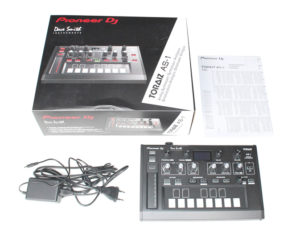

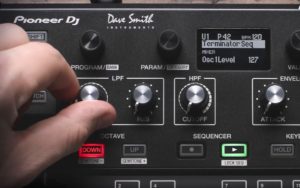
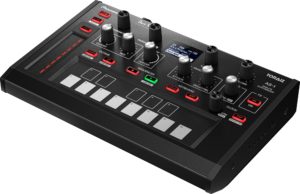
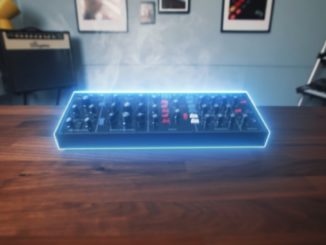
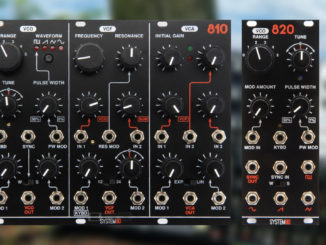
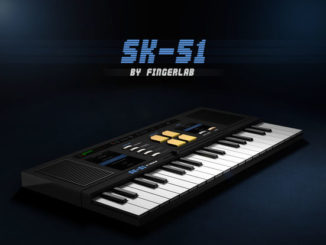
abandonware by pioneer….terrible midi sync bug means u can only really use this as a sound module